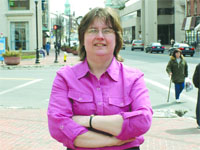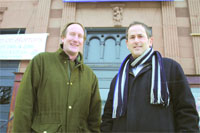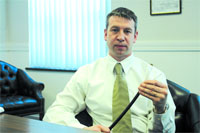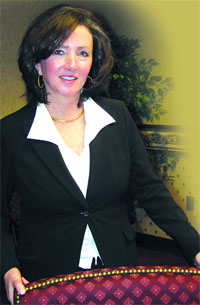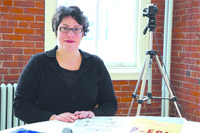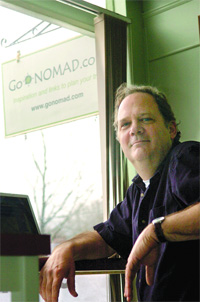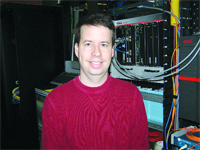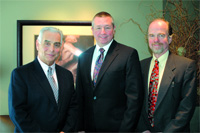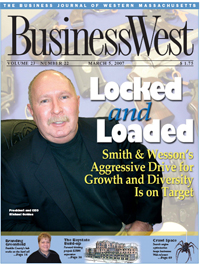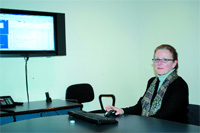When Mike Golden came to Smith & Wesson in late 2004, he laid out a strategic plan calling for diversification, across-the-board growth in the core product — handguns — and operational improvements to increase margins and profits. Two years later, he and his leadership team have made great strides with all those goals, and as a new fiscal year dawns, this company with the great brand and glorious past has an even brighter future in its sights.
There are many ways to measure the progress recorded at Smith & Wesson since Mike Golden took over as president and CEO just over two years ago.
Start with the stock price. It was about $1.40 then; it’s over $13 now. There’s the 76% growth in sales of the core product (handguns) over the past 24 months, and a 465% rise in operating profits, contributing to roughly 250 additional jobs at the Roosevelt Avenue plant in Springfield. S&W has also regained some of the market it once dominated in handgun sales to state and municipal police departments, and was named Manufacturer of the Year (2005) at the National Rifle Association’s annual convention a year ago.
And then … there’s the magazine covers — 80 of them over the past year at last count, but the number seems to go up virtually every week. These aren’t pictures of Golden, either; rather, it’s a host of new S&W products that are getting face time on some of the shooting and law enforcement realms’ most popular publications.
The January issue of American Rifleman profiled the company’s new Elite Gold shotguns; the latest cover of Guns & Weapons features both S&W’s new M&P (that stands for Military & Police) 5.6mm tactical rifle and the M&P 45 caliber pistol; the January edition of Shooting Illustrated had a close-up of one of the company’s new .44-caliber Magnum revolvers; and the cover of the current issue of American Cop announces an exclusive review of a compact model of the M&P pistol.
And these are just the most recent triumphs at the newsstand; over the past 18 months, the company has won cover stories in countless other publications, from Guns & Ammo to Special Weapons to Shooter’s Bible, the self-described “world’s standard firearms reference book since 1924.”
Spread all these out on a coffee table and they start to convey what has taken place at Smith & Wesson since Golden arrived in the fall of 2004, after 25 years of work with some other famous brands, including Black & Decker.
But new products and more aggressive marketing (those are the basic ingredients to gaining cover pieces in this industry) are only part of the story.
There are also investor relations, hard lobbying of elected officials in Washington that helped win the company its first major order from the U.S. government in more than 15 years, investments in new equipment and margin-improving processes, and diversification into product lines well beyond S&W’s bread and butter — handguns.
All these elements are part of the strategic plan Golden put in place for a company that has always had the name (with an 87% awareness level), but wasn’t, by his account, well managed or marketed when he arrived. There are several prongs to this strategic plan, and all of them essentially involve leveraging that famous brand, and putting the Smith & Wesson name on everything from black powder rifles to leather jackets to the hood of a Busch Series race car.
“Research shows that whether you like guns or don’t like guns, whether you’re male or female, young or old, Democrat or Republican, it doesn’t matter,” he explained. “The perception of the brand is extremely positive. This is a 155-year-old legacy brand that everybody knows and everybody likes, and that gives us the ability to grow the business.”
But brand recognition does not necessarily translate into sales — it didn’t at S&W for many years — so Golden and his management team put the focus on creating new products and lines that could outperform the offerings of companies that had taken market share from Smith & Wesson over the years.
The results are starting to show. The M&P pistols have been turning heads and drawing top marks at so-called T&Es, testing and evaluation periods during which police departments shopping for new weapons test what’s on the market. Those strong performances have netted some new orders from law enforcement agencies, but Golden says the company, now with just over 10% of a $150 million market it once owned lock, stock, and barrel, is just scratching the surface in that sector.
Meanwhile, it is making strong headway in the product category called long guns, which includes everything from shotguns for sport to tactical rifles for SWAT teams. In that latter category, S&W’s M&P models are so popular the company can barely keep up with orders.
In this issue, BusinessWest, in yet another cover story for this 155-year-old company, conducts a wide-ranging interview with Golden, in which he explains why, by aiming high, Smith & Wesson’s quest for a return to its glory days is clearly on target.
Bullet Points
Golden has logged considerable air miles in recent months. He’s spent a lot of time on Wall Street talking with investors and in Washington conversing with elected leaders and federal officials in efforts to bolster both domestic and international sales. In January, he spent a week in Orlando at the SHOT (Shooting, Hunting and Outdoor Trade) Show.
Smith & Wesson had two booths at the event, sponsored by the National Shooting Sports Foundation, and it needed them. The company was displaying a wide array of new products, from its new Elite Gold shotguns to six retro revolvers, including the ‘Model 40 Lemon Squeezer,” so-called because it has a grip safety on the back strap (one has to squeeze the grip in order to fire the gun), to its new M&P pistols. Those displays drew considerable attention that will no doubt lead to more magazine covers: The Army Times selected the M&P 45 as its featured product in ‘Best of Day Two’ at the show.
Beyond the new models, however, what the hordes of shooting industry media noticed from Smith & Wesson was something missing in recent years — energy, said Golden, adding that, overall, instilling some has been his broad assignment.
He’s done it by assembling an effective senior management team, which includes many newcomers as well as several S&W veterans, and by taking several pages from the scripts he helped write for Black & Decker and, after that, for the plumbing fixtures giant Kohler and the hardware and tool maker Stanley Works. These touch on matters ranging from marketing (NASCAR participation included) to dealer relations.
He’s also worked to make the company more visible to the industry and the public at large. He oversaw creation of the Smith & Wesson museum, a small, glass-walled room inside the plant that displays many historical pieces, including the S&W 38, perhaps the most famous handgun ever made; dozens of collector’s items, some valued at more than $500,000, and even some Hollywood memorabilia, such as the .44-caliber Magnum toted by Clint Eastwood in the movie Sudden Impact.
The various steps have been taken to ensure that the company with the glorious past has a real future, said Golden, adding that he believes Smith & Wesson is well-positioned for strong growth for many years to come.
“The past two years have been the most the exciting thing I’ve ever been involved with,” he said. “We’ve grown in every channel that we do business in, and we take great pride in the fact that we’ve done everything we said we were going to do.”
Indeed, when BusinessWest talked with Golden soon after his arrival, he laid out many of the points in a strategic plan for the company. It called for diversification on a number of levels, investments in new technology that would make the company more efficient and improve margins without eliminating jobs, and aggressive pursuit of market share in many domains through new sales and marketing tactics.
There has been progress on virtually all fronts.
Inside the plant, the company has implemented what it calls the Smith & Wesson Operating System, based on the Toyota Production System (TPS), or lean manufacturing. In response to increased demand for its pistol lines, the company invested more than $40 million in new technology in the form of new machining cells that that have reduced the slide-manufacturing process from 15 steps to three, and manufacturing centers that have reduced the barrel-manufacturing process from 13 steps to four.
Meanwhile, the company has made fundamental changes in its approach to sales at the sporting goods level, yielding sharp increases in handgun sales within that market.
“A year ago, we changed our sales strategy,” Golden explained, “from a channel where we used independent reps to represent half the country — salespeople who sell Smith & Wesson but also sell fishing tackle, ammunition, and many other lines — to using all Smith & Wesson factory employees who sell only Smith & Wesson.
“This was chapter right out of the Dewalt (a division of Black & Decker) power tool book,” he continued, “and it’s focused on the independent dealers. This is where the action happens; it’s where the consumer walks into the store and makes their purchasing decision.”
The results have been exactly what the company hoped for, he said, noting that the closer relationship between salesperson and dealer and the singular focus on Smith & Wesson have driven at least 30% growth in sporting goods sales for each of the past several quarters, and 52% in the most recent quarter.
These and other steps have been blueprinted and implemented by a leadership team that blends experience in the gun industry (CFO John Kelly has spent 25 years at Smith & Wesson) with work manufacturing, marketing, selling, and licensing some of the country’s most famous brands.
Tom Taylor, S&W’s vice president of Marketing, spent 24 years with Coca-Cola and Frito-Lay before joining the company two and a half years ago; Tom Fimmen, vice president of Sales, who joined the team a year ago, has logged a quarter-century of experience with such companies as Union Carbide, GE Silicones, and Stanley Works; Ken Chandler, vice president of Operations, has held similar positions with Ingersoll Rand and Autoliv; and Bobbie Hunnicut, vice president of Licensing, has 25 years of experience with Stanley Works, Meridith, and Harley-Davidson.
But while the management team has mapped the plan and executed it, the stars of this show are the new products that have rolled off the assembly line. Collectively, they have enabled the company to penetrate new markets, gain coveted federal contracts, and win back some of the police contracts that made the company a household name — and part of some of some of Hollywood’s more memorable lines.
On the Beat
Along one wall in an area of the massive plant known as the revolver fitting room are several large cork boards covered with the badges of police departments to which Smith & Wesson once sold handguns, principally revolvers. There are thousands of them on this and other displays around the plant, representing small towns, big cities, and every state police department in the country.
“It’s my job to get those people back,” said Golden, motioning to the badges and noting that the company, which once owned roughly 98% of the law enforcement market, lost nearly all of that business. It happened because it didn’t take seriously the threat posed by Austrian gunmaker Glock and its superior pistols, and this complacency cost the company dearly. “One by one, police departments converted their primary service weapon from a revolver to a pistol, and today Glock has 65% of the market.”
Getting all those state and local police forces back in the fold, and not just on the wall, is a simple function of putting out a quality product and effectively selling it, said Golden, adding quickly that law enforcement officers have no room for tradition or nostalgia when choosing weaponry; accuracy and stopping power — the factors measured at T&Es — are what sell guns.
The M&P model pistols, launched in January 2006, are winning over many departments — nearly 150, representing about 20,000 officers, were using S&W guns at last count, he said, noting that the products have a 78% win rate at the T&Es in which they’ve been involved, and that more than 130 of the nation’s 17,000 law enforcement departments are currently testing the products.
“This leaves considerable room for growth,” said Golden, adding that the company intends to achieve it by continually listening to end users (something he said it stopped doing years ago), and making products they like and trust.
But municipal and state police departments constitute just one segment of the handgun market, said Golden, noting that S&W is looking for growth in the other three — retail (for sport and home security), where the company has traditionally fared well, and U.S. government (including the military) and international sales, where, at least recently, it hasn’t.
But through better products (those M&P models), some effective lobbying (the company hired a firm to keep its name front and center), and support from U.S. Rep. Richard Neal and others, Smith & Wesson is getting some consideration — and some new contracts.
In late 2005, the company won $20 million in government business (all four of the contracts awarded for firearms) totaling more than 73,000 pistols for the Afghanistan National Police and Border Patrol, said Golden, noting that more penetration in this sector could be on the horizon. Indeed, there are indications that the U.S. armed forces may be switching from a 9mm pistol (Beretta is near the end of a 20-year contract to produce them) to a 45-caliber model — and Smith & Wesson just launched its M&P 45, as Guns & Weapons and some of those other publications announced.
Details on the new military contract are emerging — specifications are due to be released later this year — but Golden said it may involve nearly 700,000 guns and be worth between $300 million and $500 million. Recognizing the size and scope of that contract led Golden to hire a lobbying firm to state S&W’s case, and he believes the combination of product quality and lobbying will effectively position the company to win that huge contract.
As for international sales, the company is taking several steps to improve market share in that realm. It is increasing its sales force to develop more contacts within police and military outfits in Europe, Latin America, Asia, and the Middle East. Meanwhile, in Washington, it is lobbying for a shortening of the federal export approval timeline and a raising of the $1 million Congressional approval export threshold.
Magazine Racks
As large as the handgun market is (currently about $600 million), the long-gun market is 80% larger ($1.1 billion), said Golden, using that simple statistic to explain why S&W has penetrated many areas within that realm. And it does so with the intention of capitalizing fully on that 87% brand-recognition rate and the apparent across-the-board faith in that brand among Democrats, Republicans, and every other category.
“Our research showed that many people believed Smith & Wesson was already in the shotgun and hunting rifle business,” he explained. “When we asked them about the brands they preferred in those categories, the No. 3 brand they listed was Smith & Wesson, and we weren’t even in those businesses. That’s when we knew there was an opportunity to get into that.”
S&W started its long-gun movement with the production of tactical rifles, the fastest-growing segment in that market, because they are used by many constituencies, including the military, law enforcement, sport hunters, and competitive shooters. The M&P 15 series, introduced in March 2006, is proving popular with all
hose groups, said Golden, noting that the company is being challenged to meet orders.
“The demand has been phenomenal,” he said, noting that in less than a year, sales and orders for the M&P 15 now exceed 10% of the tactical rifle market (now more than $152 million), and 55 law enforcement agencies have ordered the product. “We’ve told our salespeople, ‘don’t aggressively sell it, because we’re selling every piece we can make.”
Penetration into the long-gun market has also manifested itself in a partnership with a company in Southern Turkey to produce the first shotguns to bear the Smith & Wesson name. And late last year, the company announced the acquisition of Rochester, N.H.-based Thompson/Center Arms, a 41-year-old venture that is considered a leading player in black powder and interchangeable firearms, for $102 million.
The Thompson acquisition provides many benefits for Smith & Wesson, said Golden, including immediate entry into hunting rifles, long-gun barrel manufacturing expertise that will help accelerate S&W’s growth in rifle sales, and an expansion and strengthening of distribution channels.
The move into long guns is part of a broader strategy to diversify the company into products across four main categories — safety, security, protection, and sport. “Because this is what the brand stands for,” he said, adding that this includes products beyond firearms, everything from handcuffs to explosion-detection devices; from flashlights to pocket knives.
But through licensing, the company will also puts its name on T-shirts, caps, leather jackets, purses, backpacks, and more, he said, adding that this initiative is part of the same marketing plan that has the Smith & Wesson name on the #30 car on the Busch circuit.
Diversification also comes in the form of specially engraved guns — for which there is a solid market — and commemorative pieces, including two special ones in 2006: the 50th-anniversary edition of the Model 29 .44-caliber Magnum made famous by the Eastwood character character in Dirty Harry, and the 75th anniversary edition of the Walther PPK, made famous by Ian Fleming’s James Bond character.
Add all this up, and it’s more than enough to keep the sporting arms and law enforcement press busy — and Golden eternally optimistic about 2007 and well beyond.
“We think there are great opportunities for growth in handguns, long guns, across the board,” he said. “And we’re solidly positioned to achieve that growth. We’ve moved aggressively, and the pieces are in place.”
Clip Files
In his piece on S&W’s compact M&P, American Cop writer Mark Henten described the gun this way: “It’s definitely a well-thought-out handgun built with the combat demands of today’s cops and soldiers in mind.”
He also said it was a return to “the good old days,” referring, ostensibly, to the time when Smith & Wesson dominated the police market through quality products and its reputation.
This, in a nutshell, is what Golden and his team had in mind when it put together that strategic plan more than two years ago: making the past prologue.
The sales numbers, stock price, NRA awards, and all those magazine covers show that this company’s broad battle plan is certainly on target.v
George O’Brien can be reached at[email protected]






